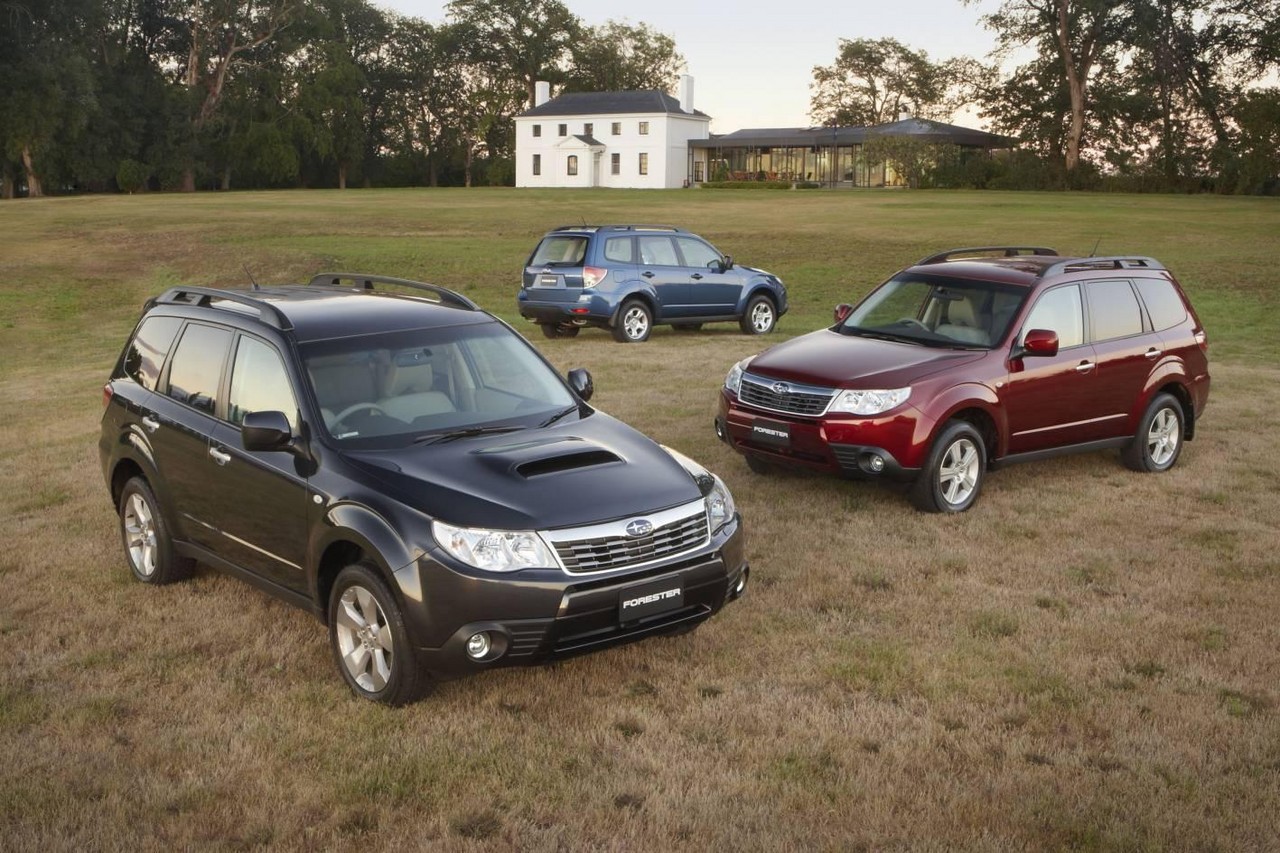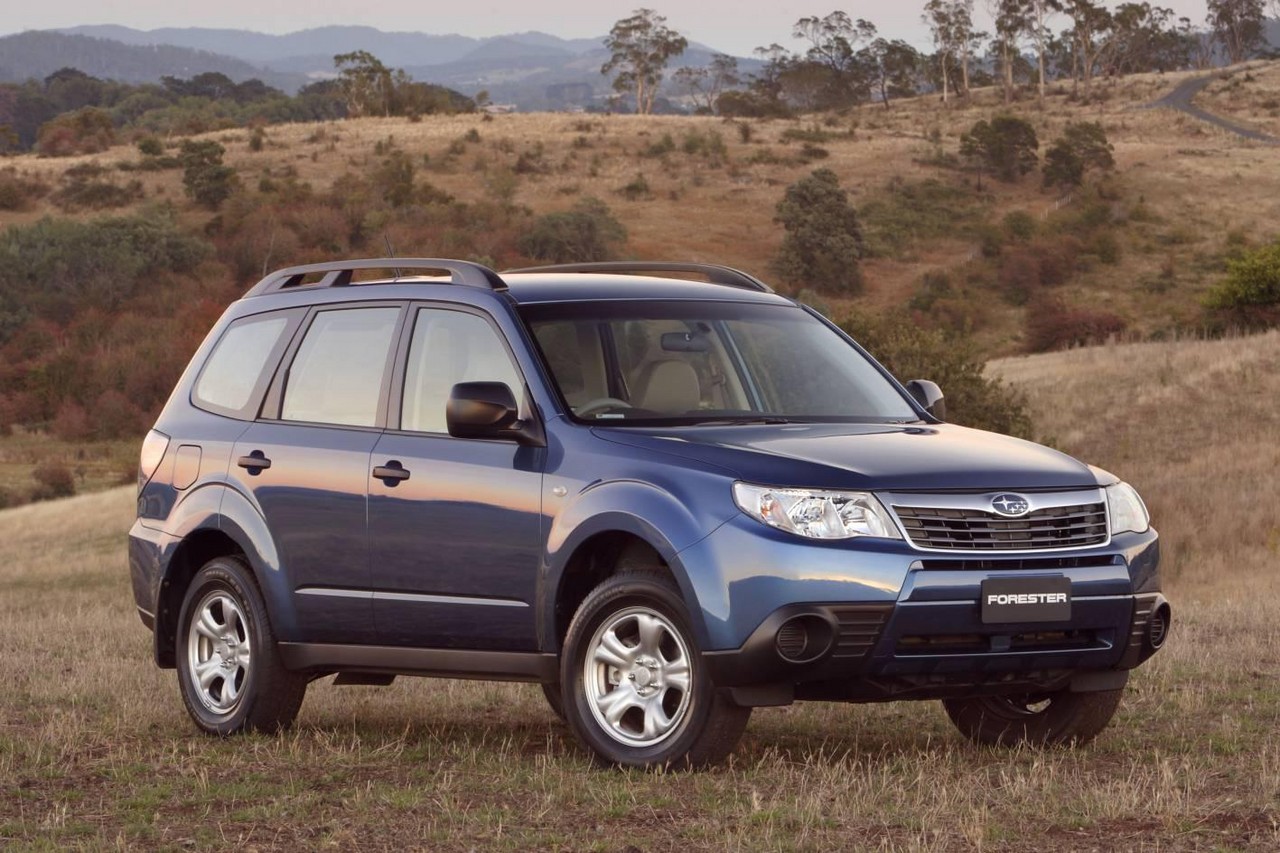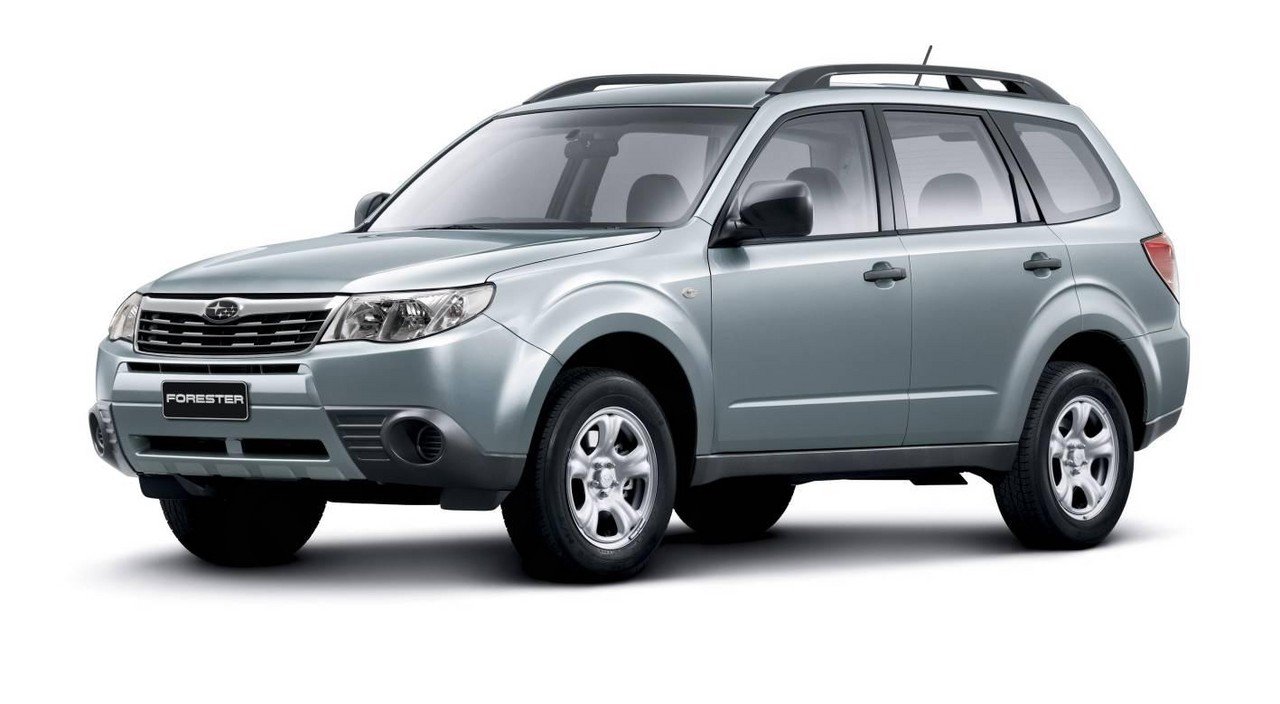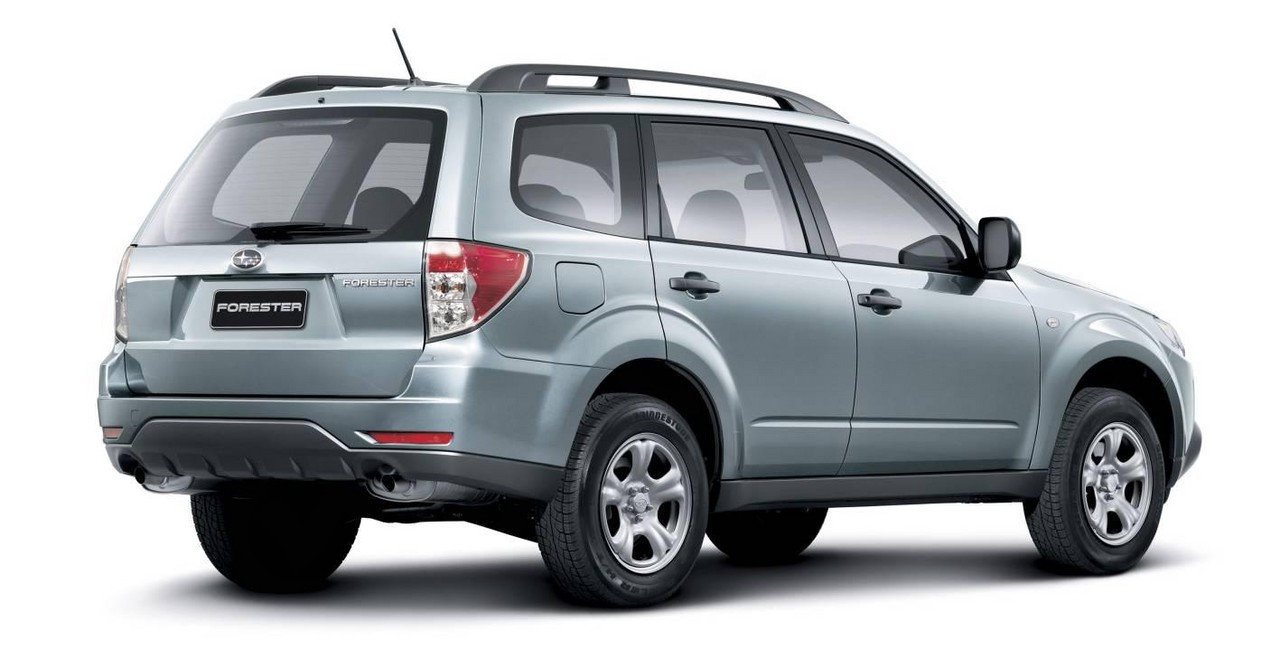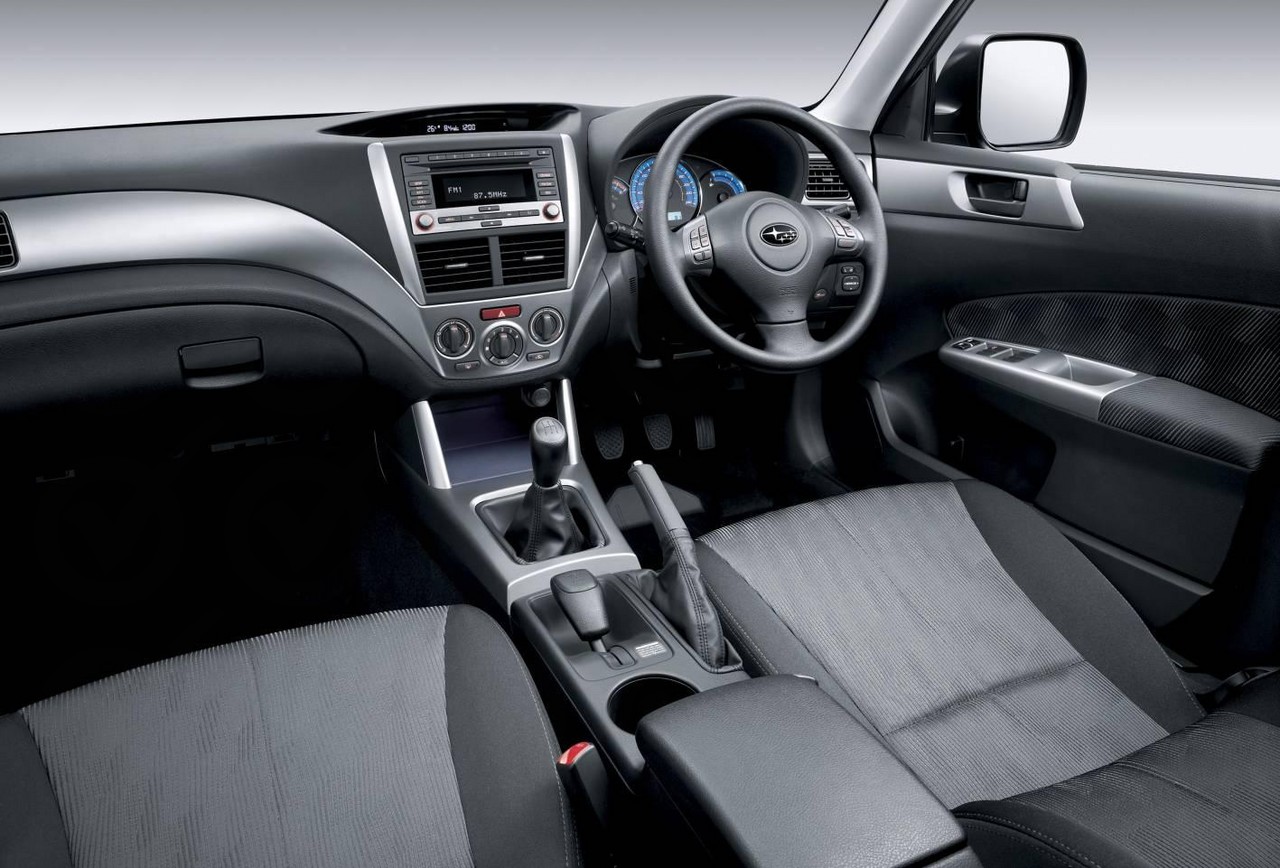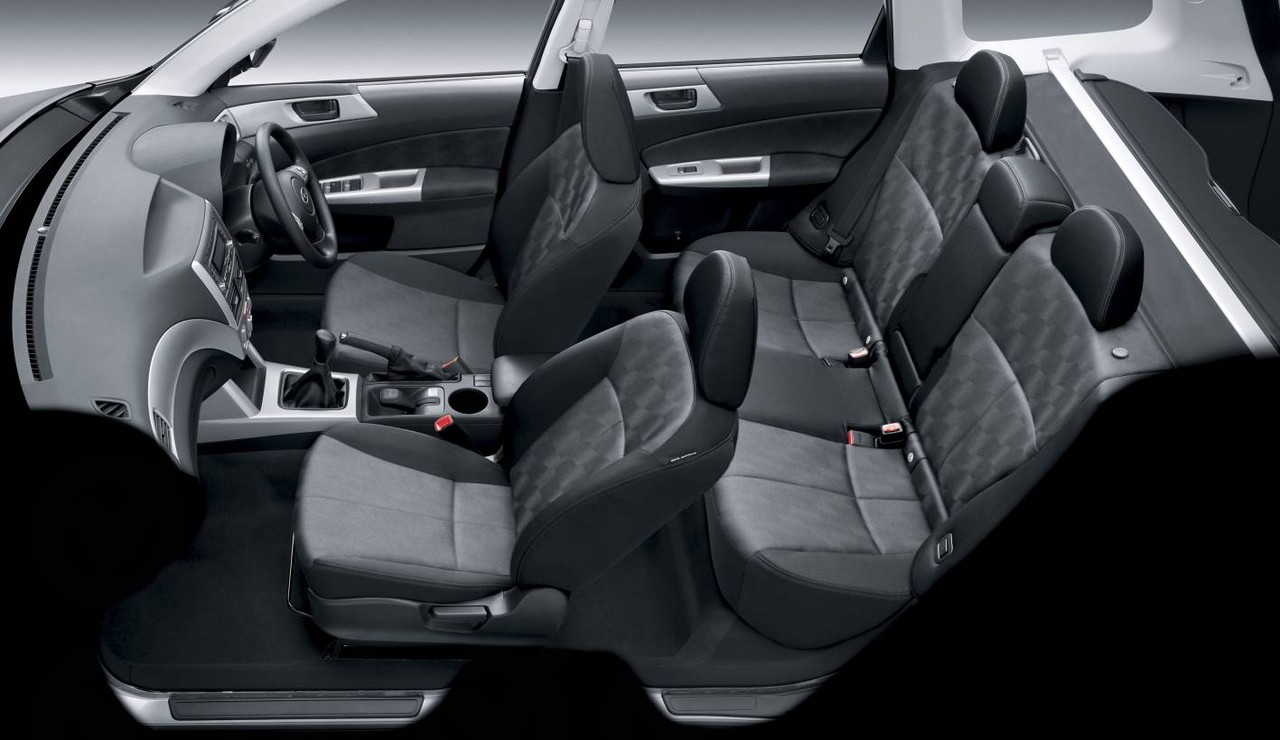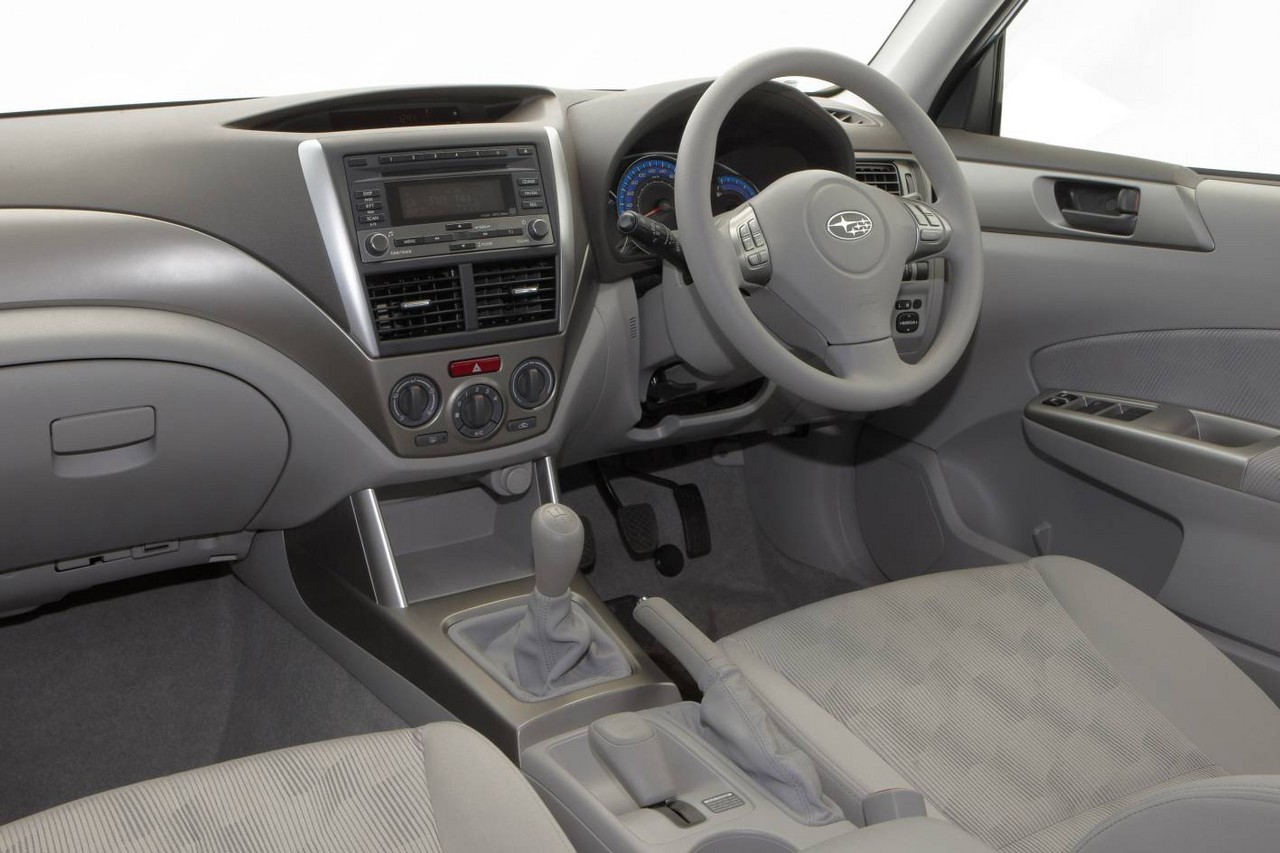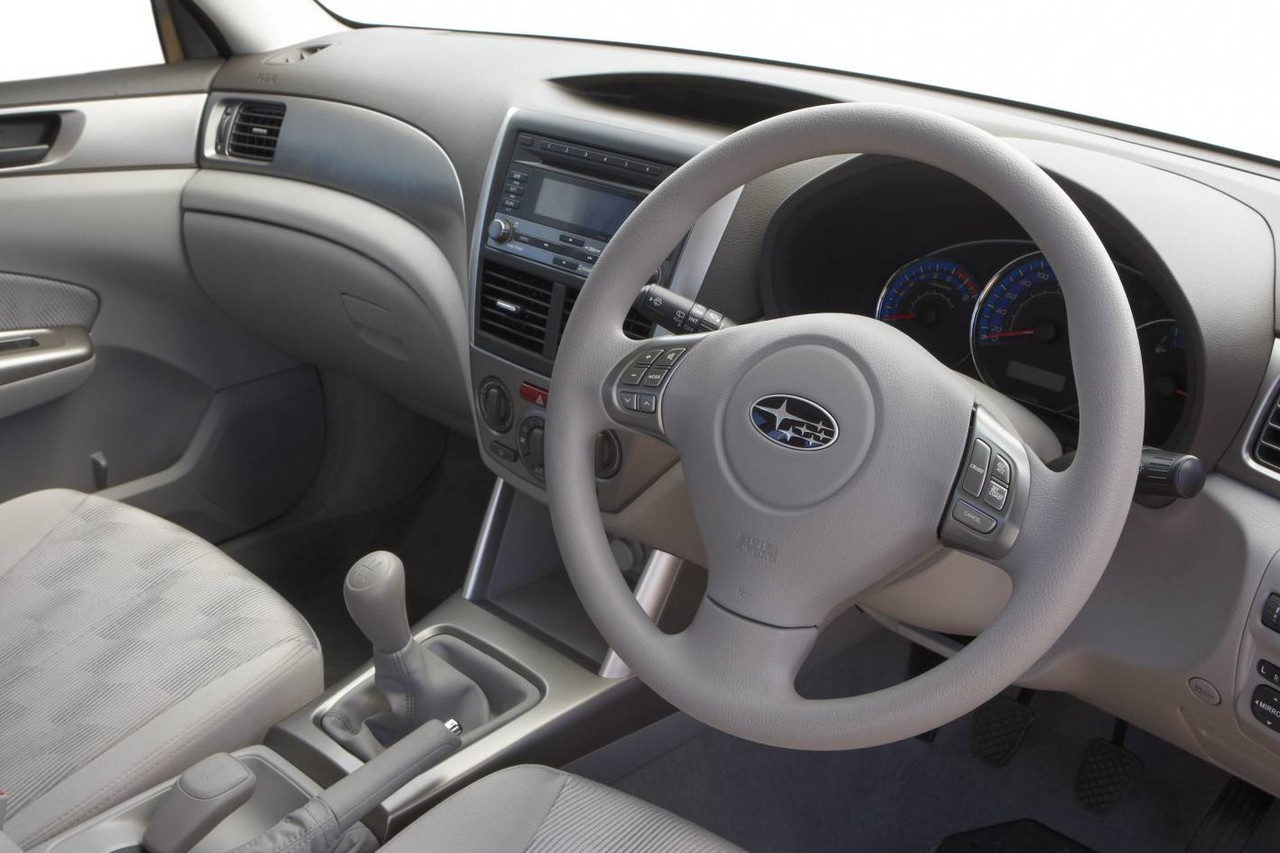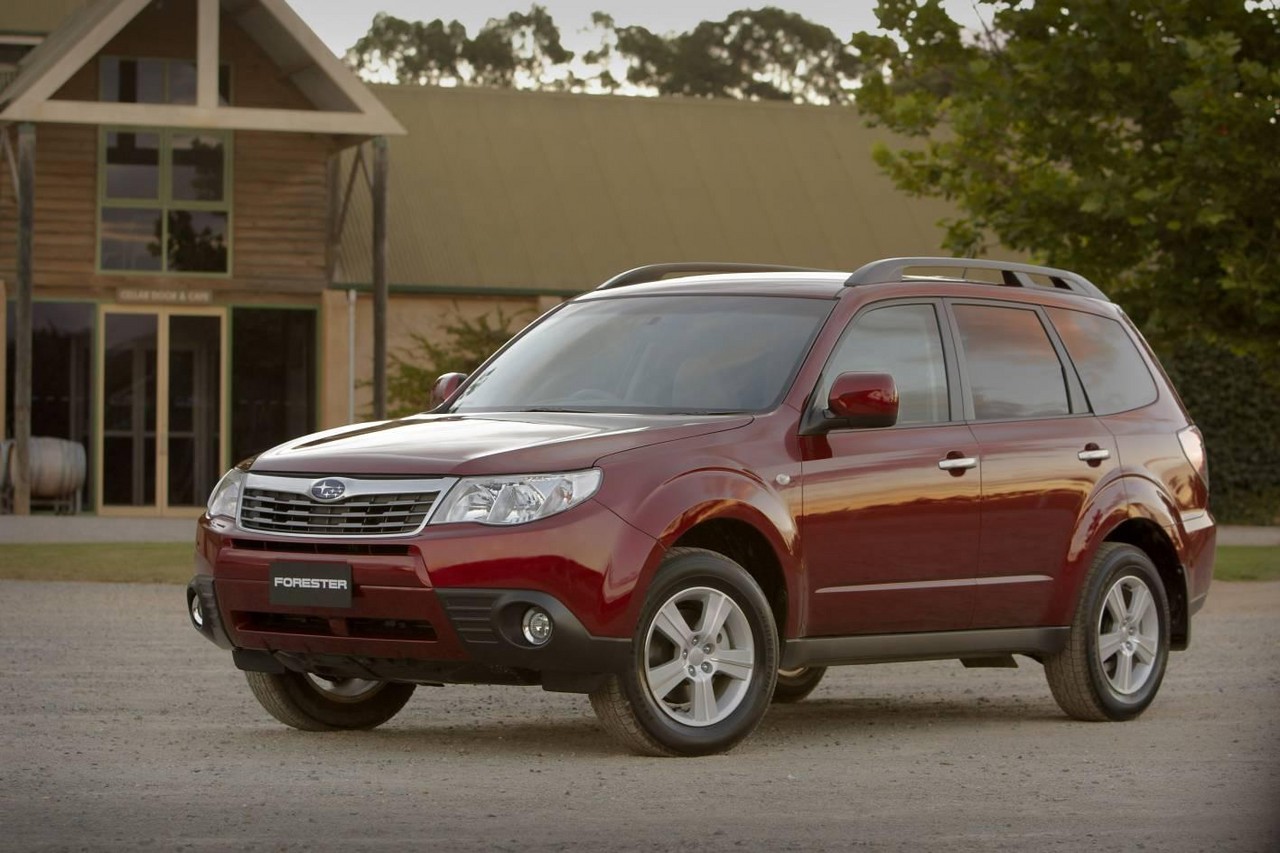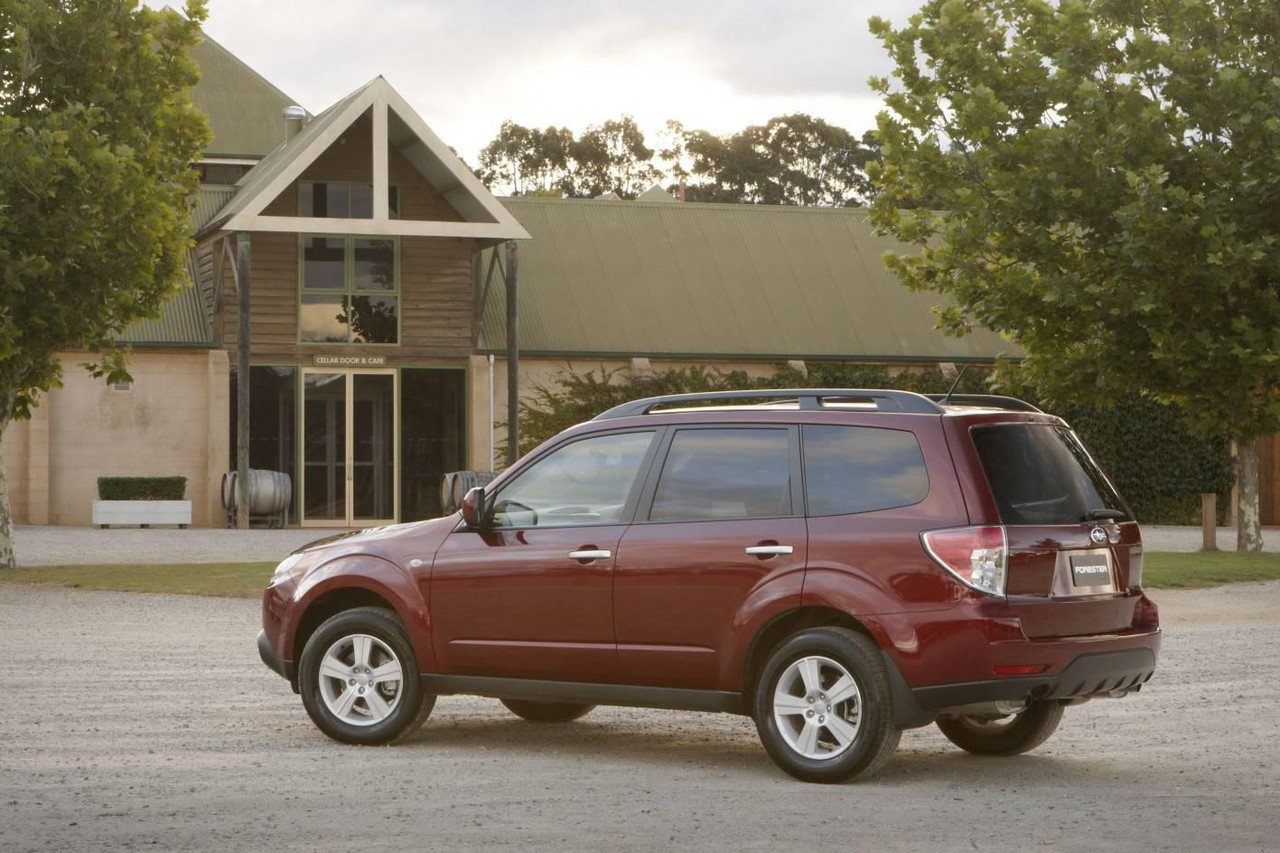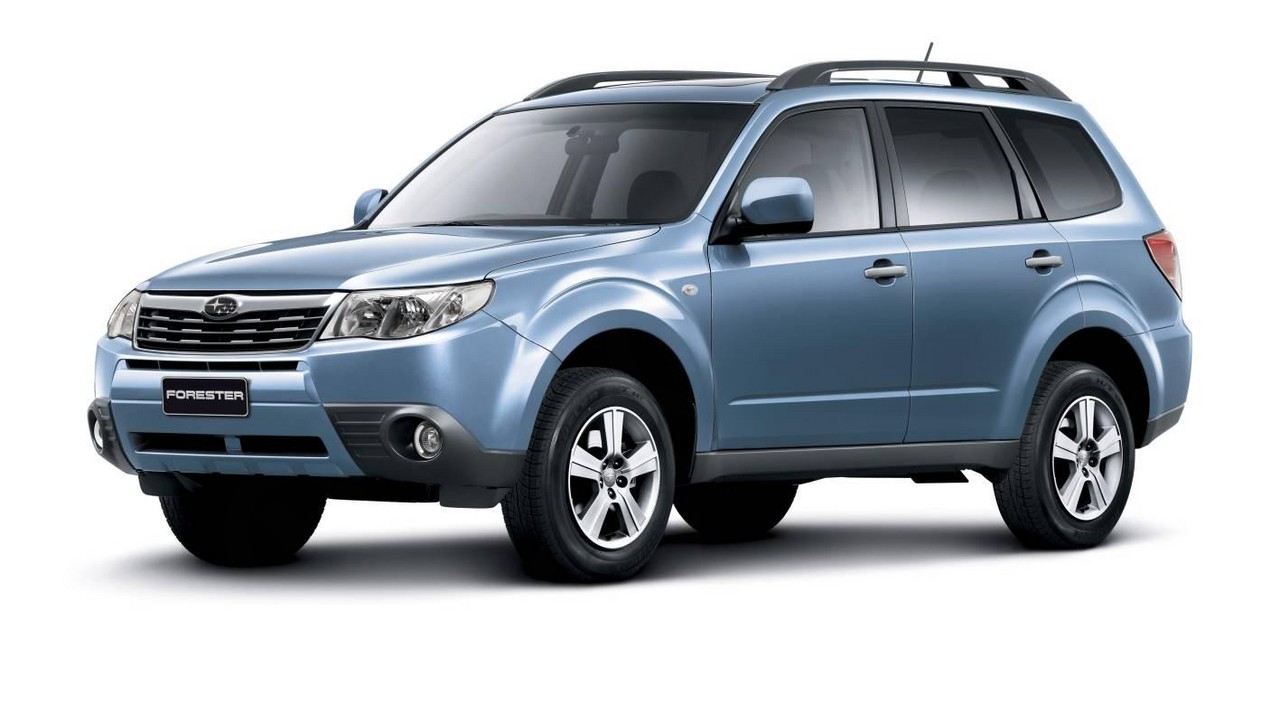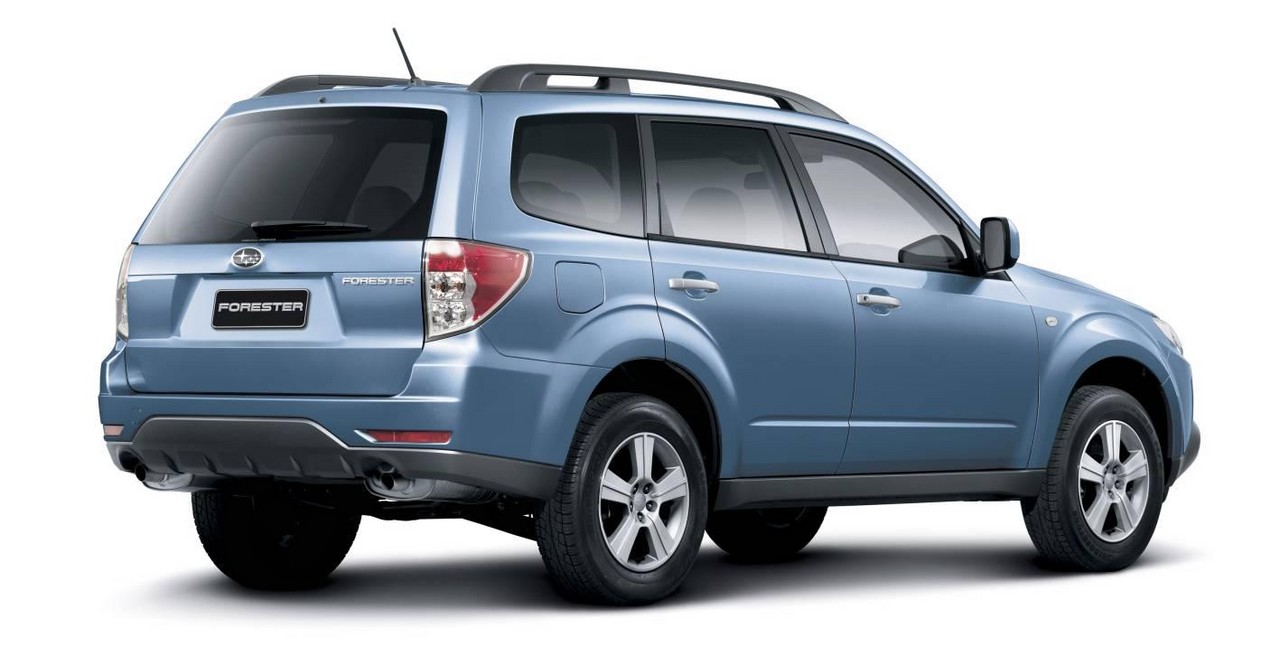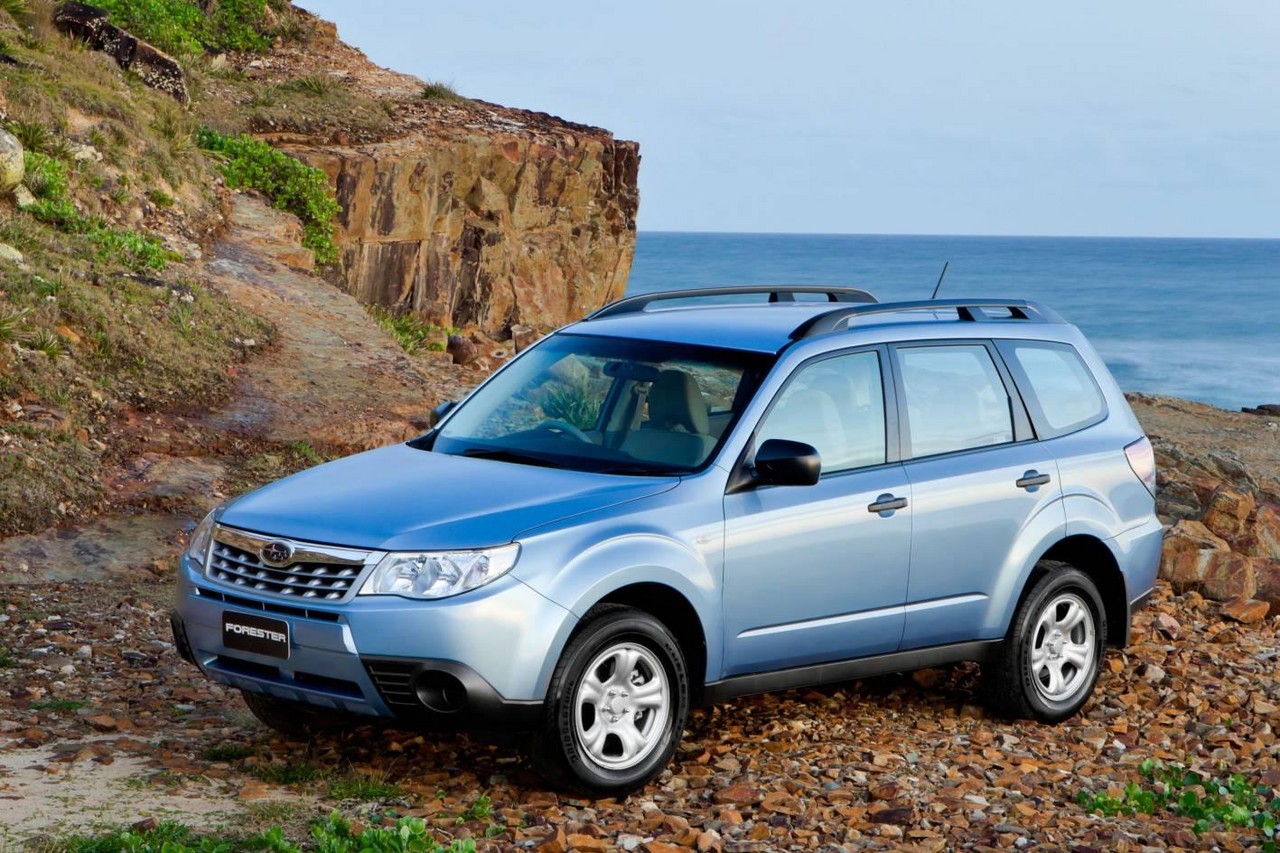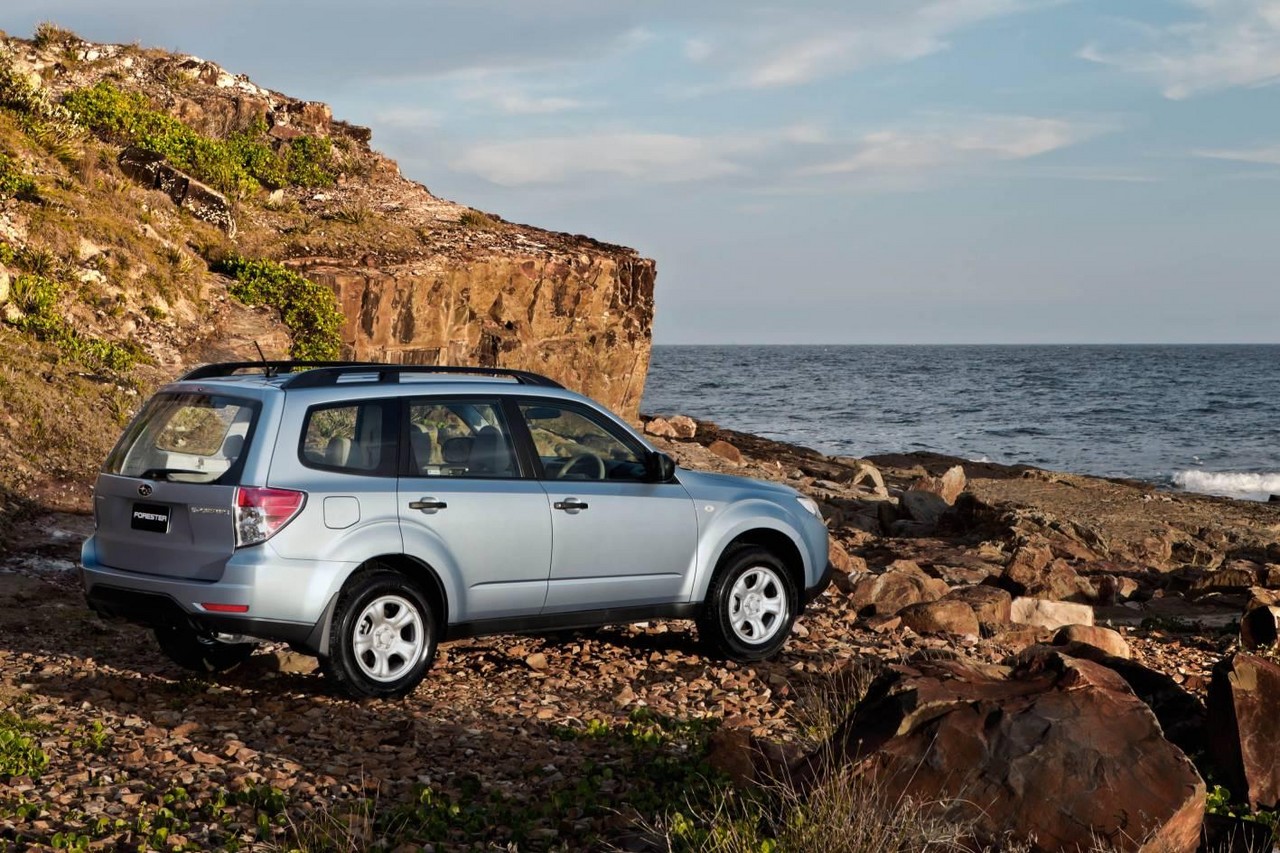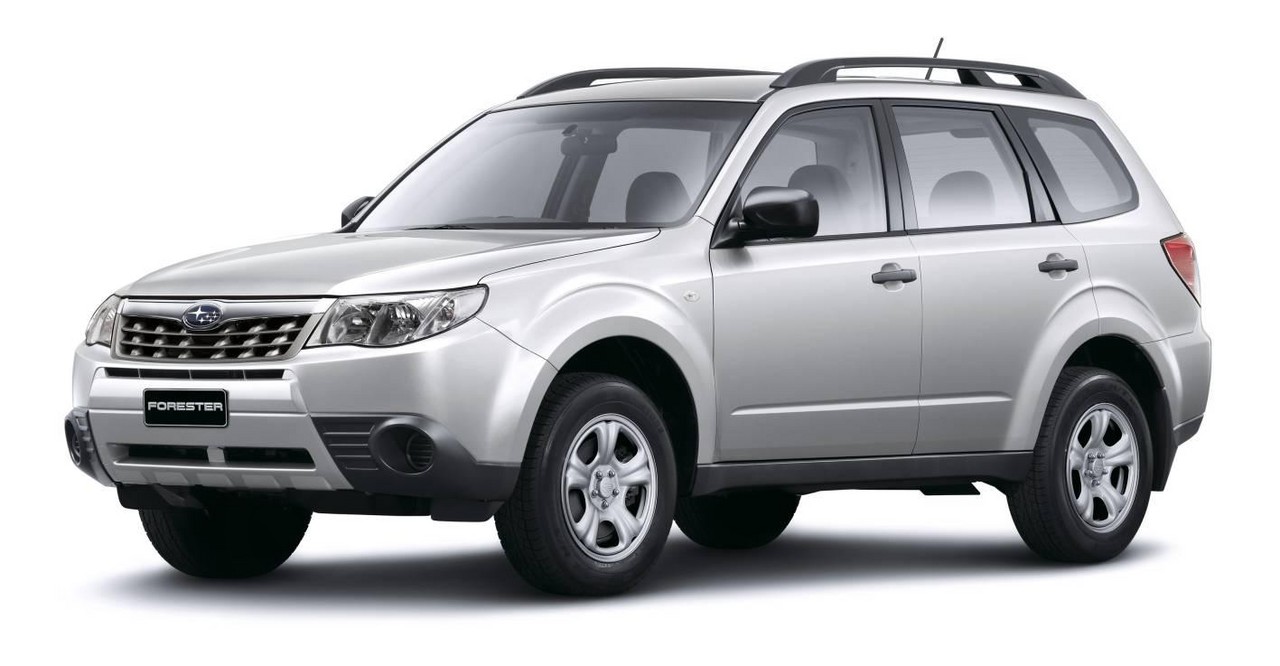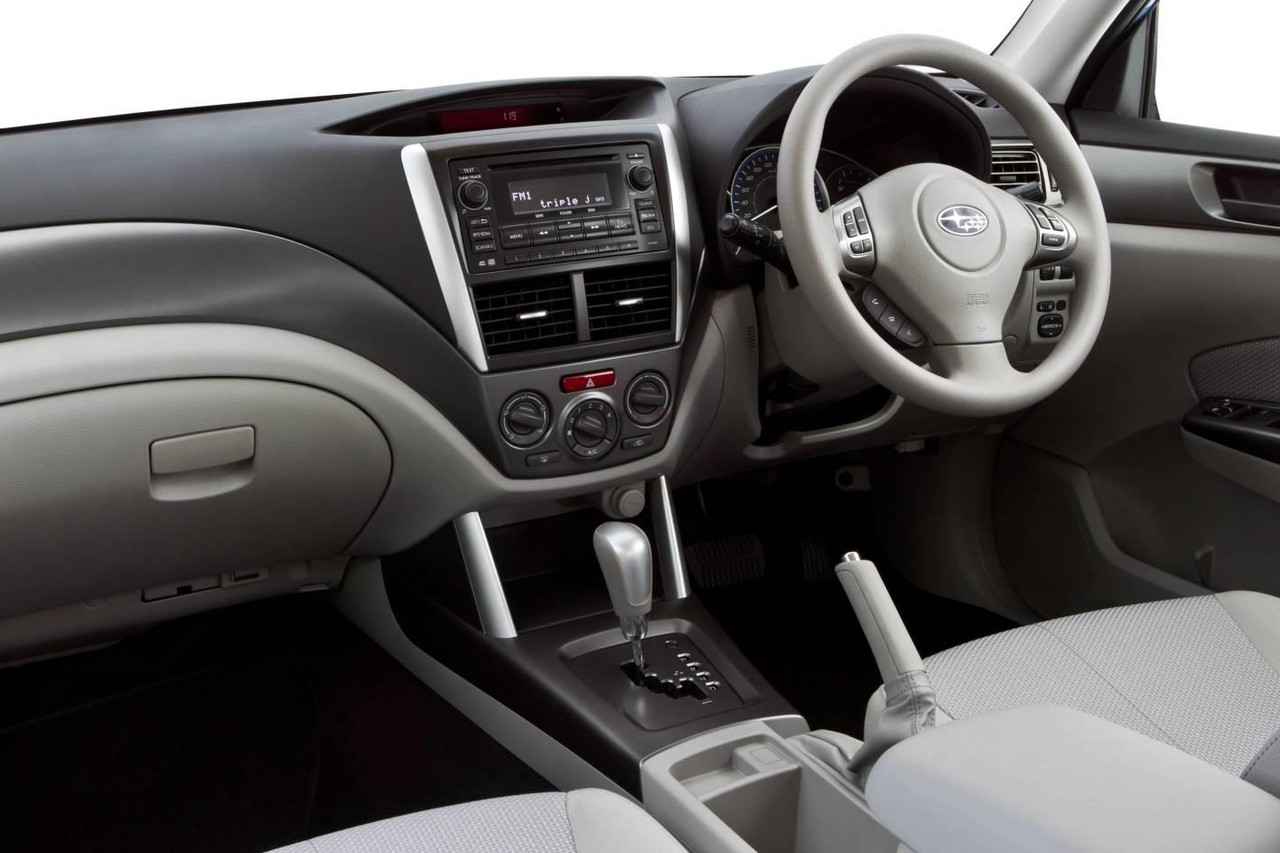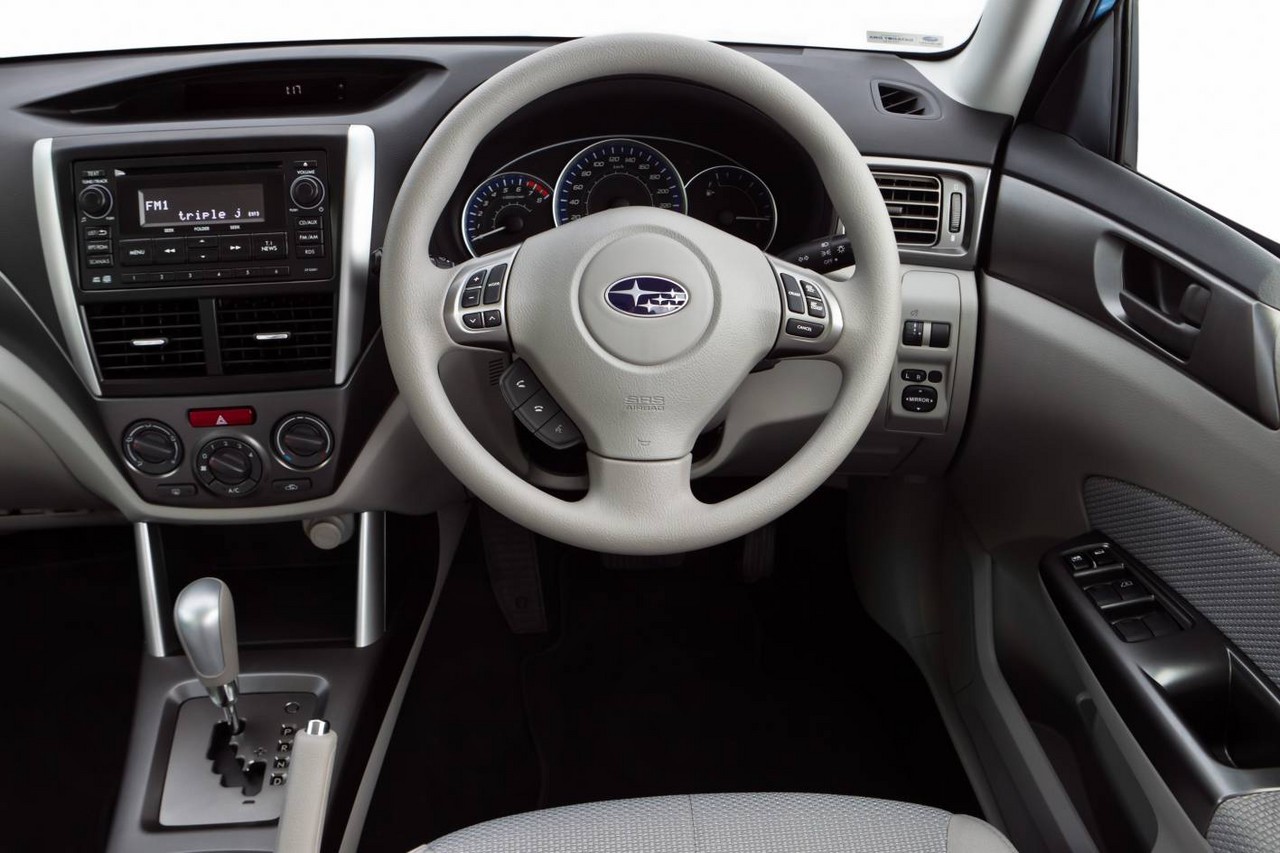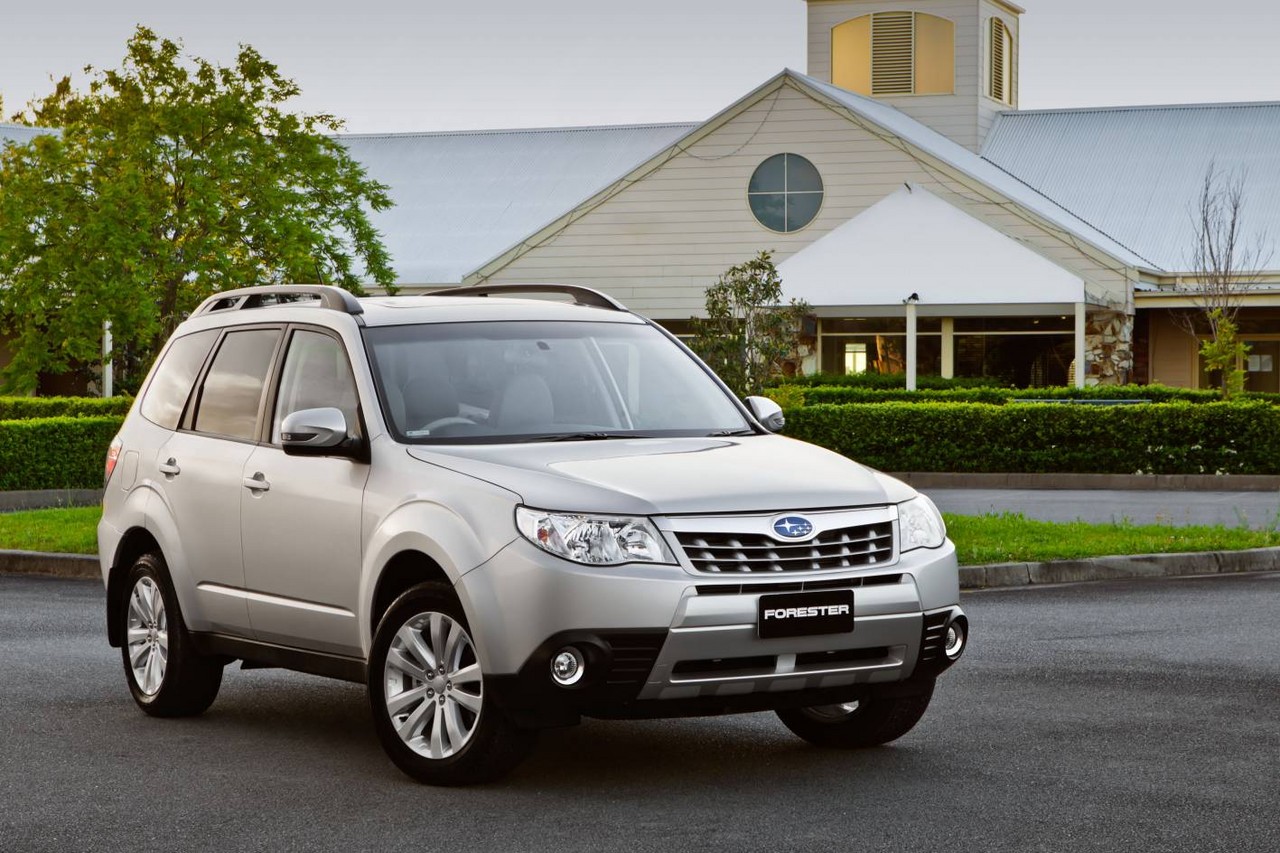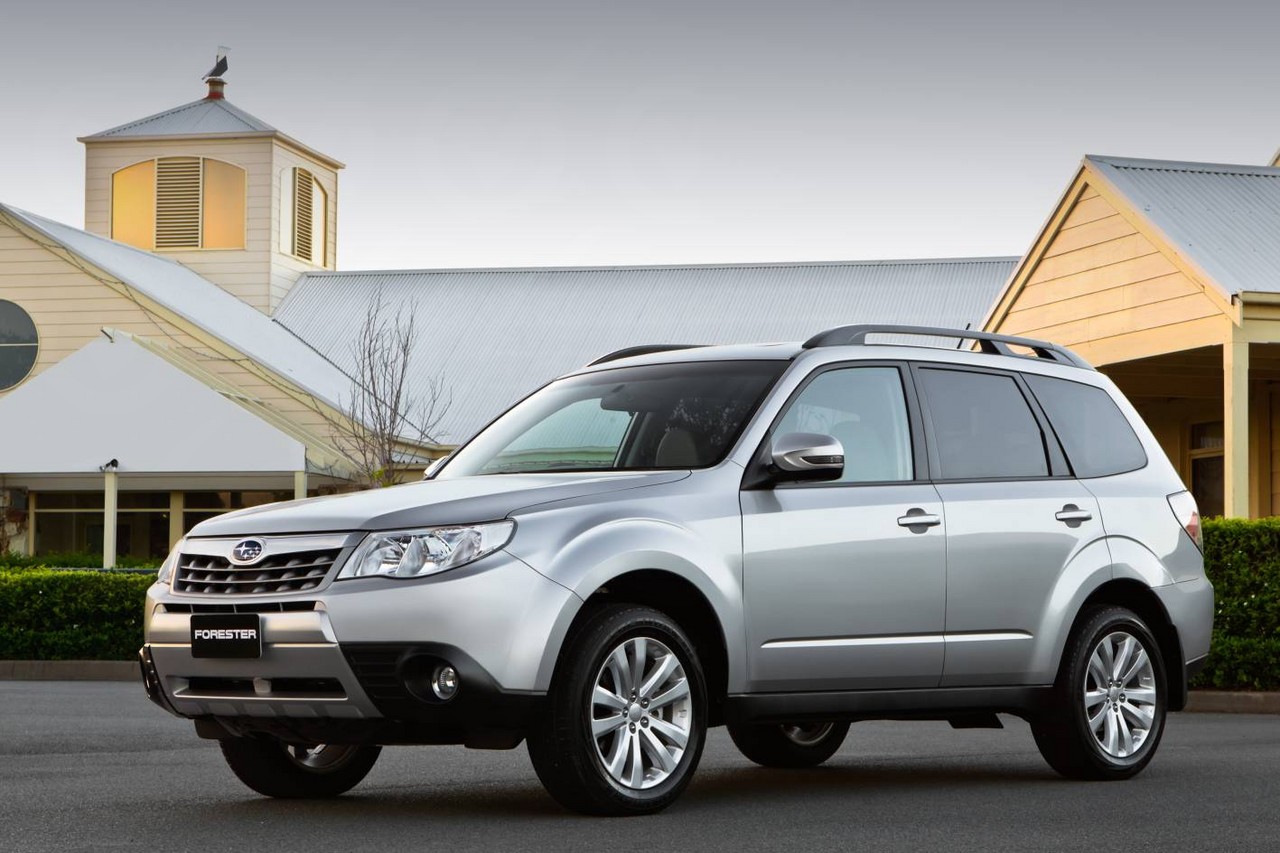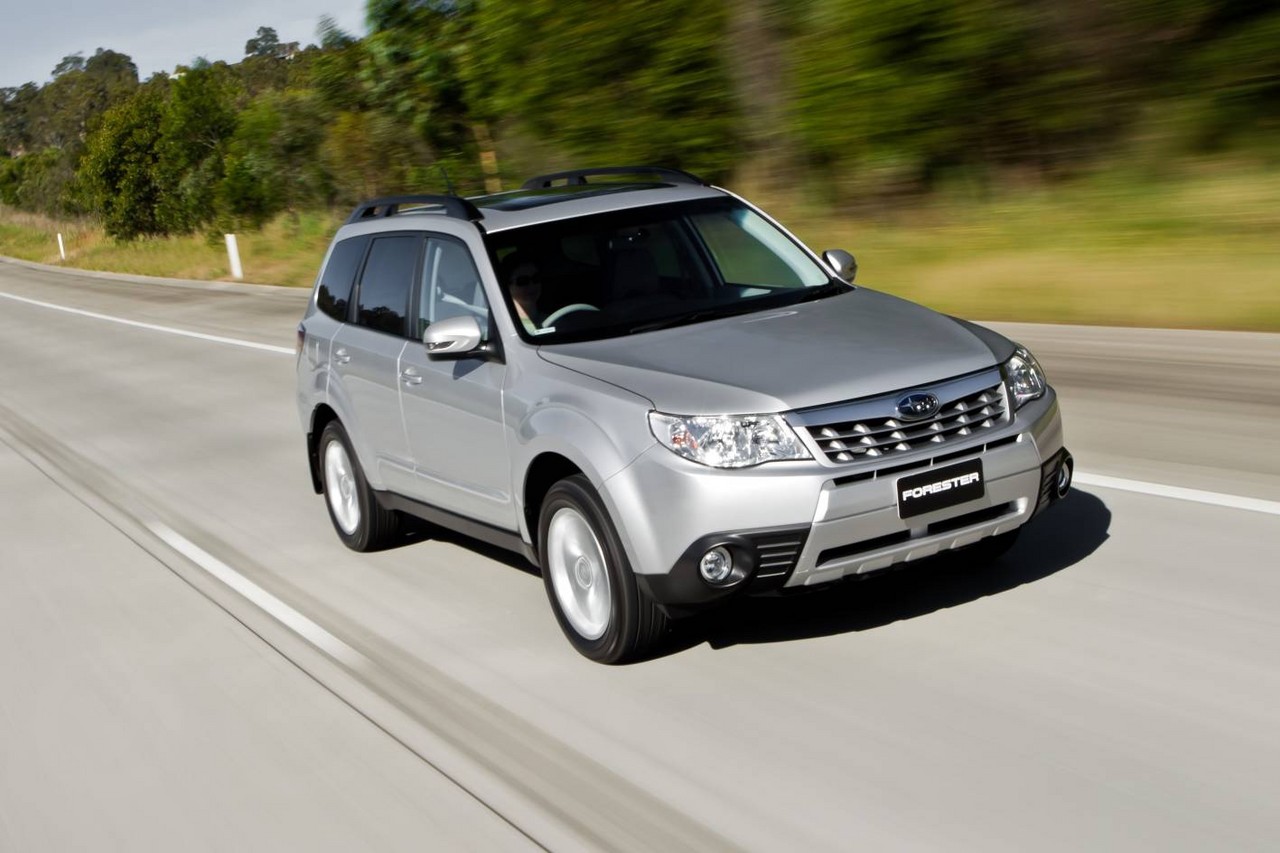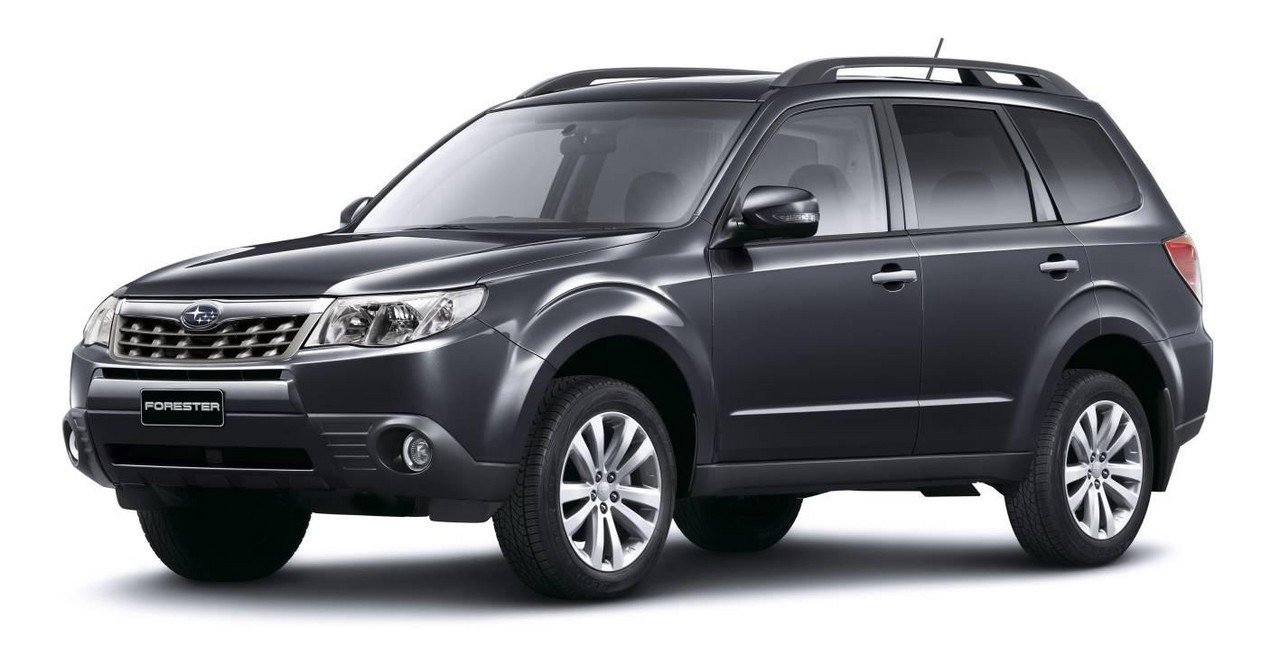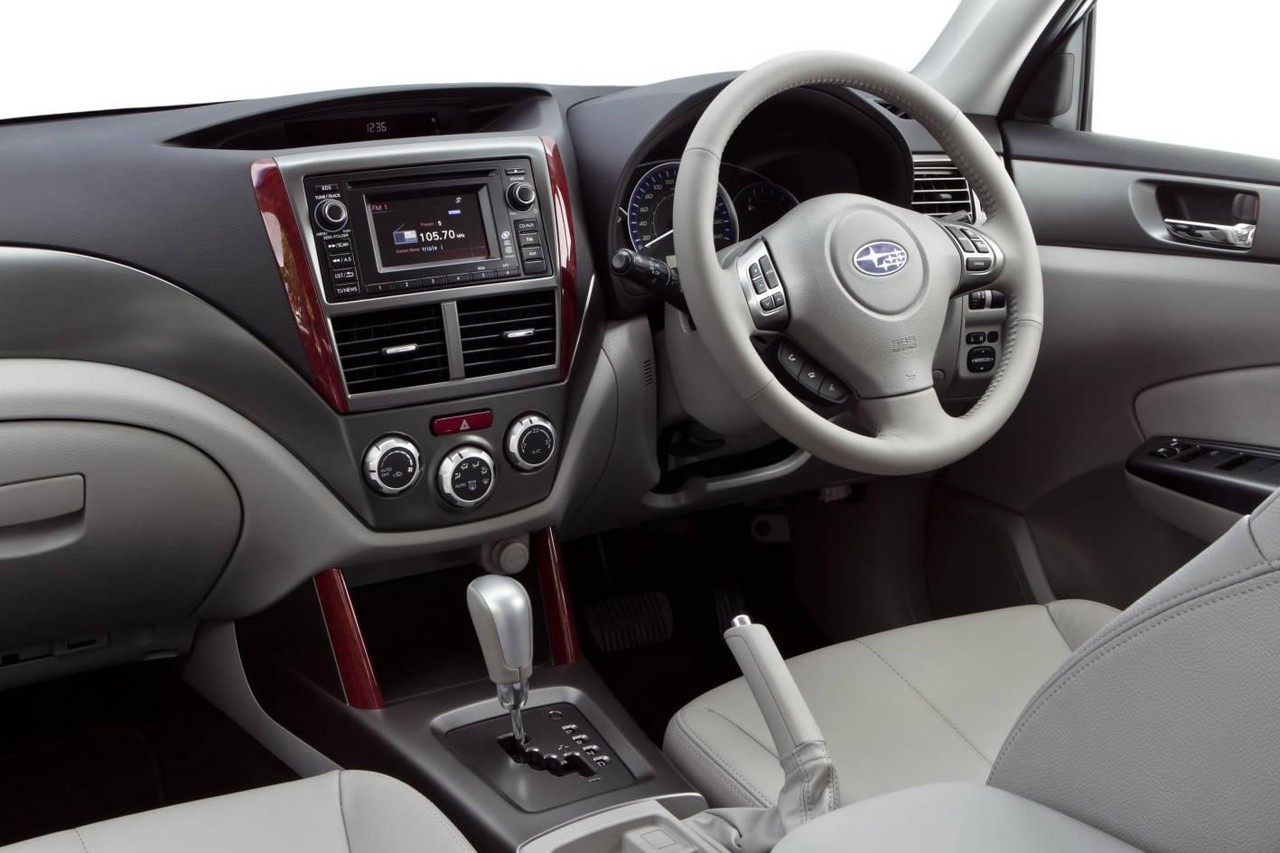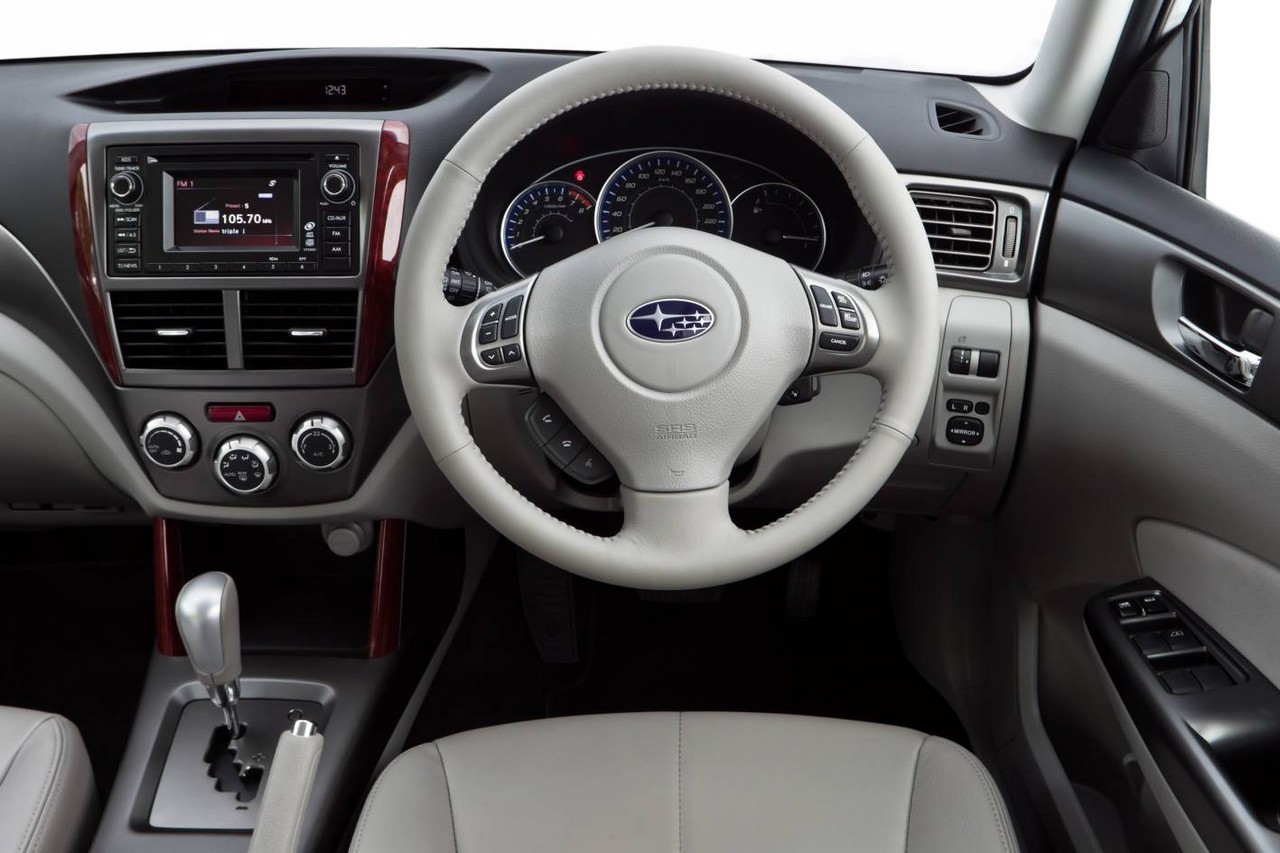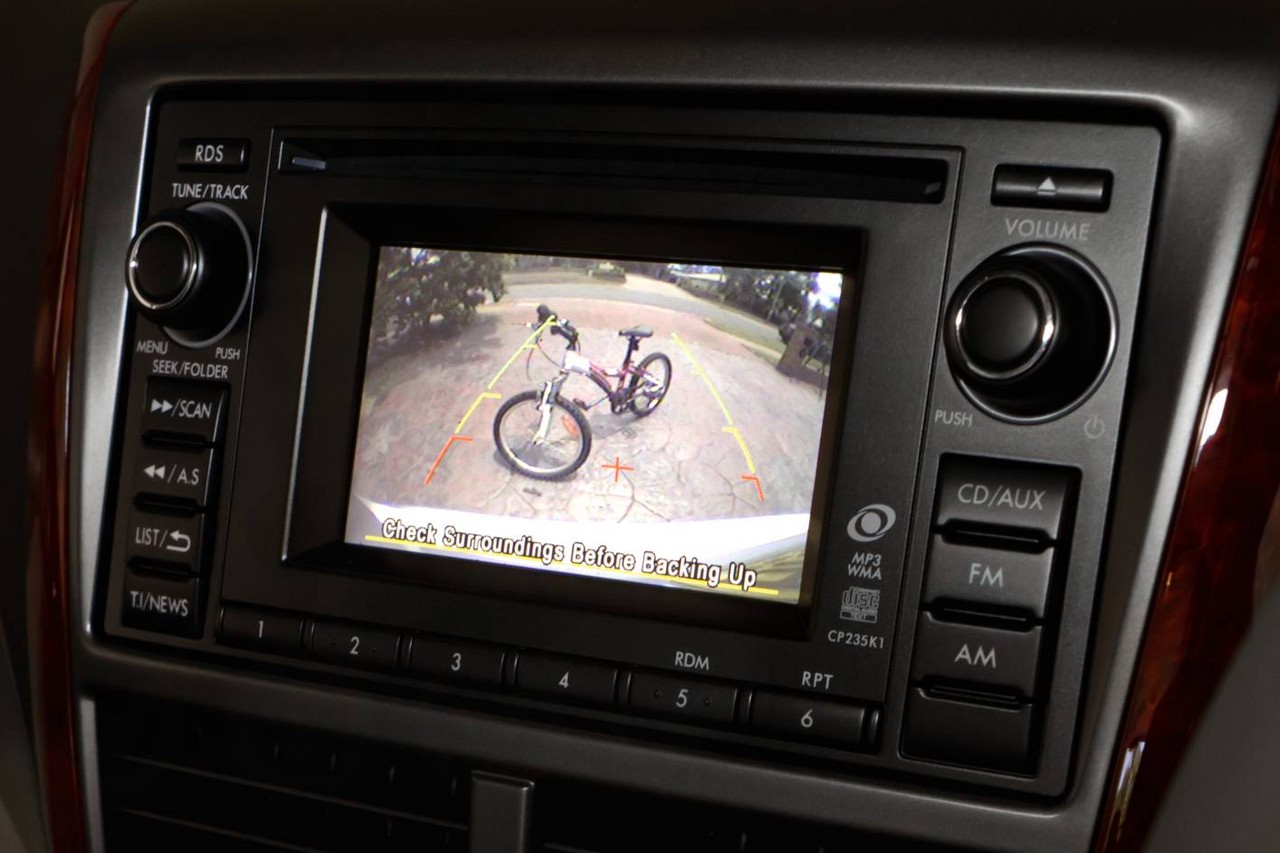
- Forester XT has powerful 2.5-litre turbo engine
- Comfortable ride
- Spacious interior
- Vague steering lacks feel
- For 2.5-litre petrol engine, noise at higher rpm
- For 2.5-litre petrol and 2.0-litre diesel engines, notchy manual gearshift action
- Body roll when cornering
- Interior plastics easily marked
Review: Subaru SH.I Forester (2008-10)
Overview
Released in March 2008, the Subaru SH Series I (SH.I) Forester was a five seat, all-wheel drive SUV. Manufactured in Ota, Japan, the Subaru SH Forester range was initially powered by naturally aspirated and turbocharged 2.5-litre boxer (or flat) four-cylinder petrol engines. In June 2010, however, the Forester range was expanded with the introduction of 2.0-litre turbo-diesel engines.
EJ253, EJ255 and EE20 engines
Of the engines,
- The naturally aspirated, 2.5-litre EJ253 boxer engine had an open-deck aluminium alloy block with cast iron liners, an aluminium alloy cylinder head, a single overhead camshaft per cylinder bank (belt-driven), four valves per cylinder, Tumble Generator Valves (TGV) and a compression ratio of 10.0:1. For the SH Forester, the EJ253 engine included Subaru’s ‘Intelligent Active Valve Lift System’ (i-AVLS’) which could vary the lift of one intake valve per cylinder between low and high lift profiles. At lower engine speeds, the low lift profile increased the speed of the intake air and swirl within the combustion chamber. At higher engine speeds, the high lift profile reduced intake resistance for greater power;
- For the Forester XT, the turbocharged 2.5-litre EJ255 engine had a semi-closed die-cast aluminium block with cast iron liners, an aluminium cylinder head with cross-flow cooling, double overhead camshafts per cylinder bank (belt-driven), four valves per cylinder, variable intake valve timing (Subaru’s ‘Active Valve Control System’ or AVCS), Tumble Generator Valves (TGVs) and a compression ratio of 8.4:1. For the SH Forester XT, the EJ255 engine had a Mitsubishi TD04L turbocharger; and,
- The 2.0-litre EE20 diesel engine had an aluminium alloy block, common-rail injection (operating at 1800 bar), a variable geometry turbocharger, double overhead camshafts, four valves per cylinder and a compression ratio of 16.3:1.
Transmission choices were a four-speed automatic (with Subaru’s ‘Sportshift’ sequential shift function) or five-speed manual, the latter with low range gearing for the X and XS variants.
Body and dimensions
The Subaru SH Forester had a stronger body which utilised elements of the GE/GH Impreza platform. Compared to its SG Forester predecessor, the SH Forester was 75 mm longer (at 4560 mm), 60 mm wider (1795 mm), 110 mm taller (1700 mm) and had a 90 mm longer wheelbase (2615 mm); ground clearance also increased to 220 mm for the X and XS variants and 225 mm for the XT. Furthermore, greater refinement was achieved through the introduction of framed windows, double-layered door seals and weather strips.
Suspension
The SH Forester had MacPherson strut front suspension and a new double wishbone rear suspension system.
| Variant | Edition | Years | Engine | Trans. | Peak power | Peak torque |
|---|---|---|---|---|---|---|
| X | [N/A] | 2008-10 | 2.5-litre EJ253 petrol F4 | 4sp auto, 5sp man. (dual range) |
126 kW at 6000 rpm | 229 Nm at 4400 rpm |
| Limited Edition | 2009 | |||||
| Columbia | 2010 | |||||
| Luxury | 2010 | |||||
| Ski FX | 2010 | |||||
| XS | [N/A] | 2008-10 | ||||
| Premium | ||||||
| 2.0 Diesel | [N/A] | 2010 | 2.0-litre EE20 turbo-diesel I4 | 6sp man. (dual range) |
108 kW at 3600 rpm | 350 Nm at 1800-2400 rpm |
| Premium | ||||||
| XT | [N/A] | 2008-10 | 2.5-litre EJ255 turbo petrol F4 | 4sp auto, 5sp man |
169 kW at 5200 rpm | 320 Nm at 2800 rpm |
| Premium |
AWD systems
The Subaru SH Forester was available with three all-wheel drive (AWD) systems:
- Models with manual transmissions were fitted with Subaru’s ‘Continuous’ AWD system which utilised a viscous-coupling locking centre differential. In normal conditions, the system provided a 50:50 front:rear torque distribution. If traction was lost, however, up to 98 per cent of the engine’s torque could be directed to the opposing axle.
- For models with automatic transmissions, an ‘Active Torque Split’ system was fitted, consisting of an electronically-controlled, hydraulic multi-plate transfer clutch (instead of the centre differential). In normal conditions, the system provided a 95:5 front:rear torque split but sensors – measuring wheel slippage, throttle position and braking – could anticipate a loss of front-wheel traction and transfer torque to the rear axle.
Furthermore, all Foresters were fitted with a limited slip rear differential as standard.
Safety equipment
Standard safety equipment for the Subaru SH Forester included dual front airbags, front side airbags, full-length curtain airbags (i.e. for front and rear occupants), ABS, brake assist, electronic brake force distribution, traction control, electronic stability control, traction control, active front seat head restraints and front seatbelts with pretensioners and load limiters. Manual models were also fitted with Hill Start Assist to prevent the car from rolling backwards on take-off.
ANCAP crash testing
In ANCAP crash testing , the SH Forester X received a five star adult occupant protection rating with a score of 34.31 out of 37. In the offset crash test, protection from serious lower leg injury was marginal for the driver. In the side impact and pole tests, however, maximum points were awarded.
Features: Forester X, XS and XT
Standard features for the Subaru SH Forester X included 16-inch steel wheels with 215/65 R16 89V Bridgestone tyres, a four speaker sound system with CD player, auxiliary input and MP3/WMA compatibility, air conditioning, steering wheel audio controls, 60/40 split and folding rear seats, remote central locking, power mirrors and windows, tilt and telescopic steering wheel adjustment, a height adjustable driver’s seat, three 12 volt power outlets, a cargo cover, full size spare wheel, roof rails and an immobiliser.
The Forester XS added 16-inch five-spoke alloy wheels, climate control air conditioning, a seven speaker sound system (including subwoofer) and a six-stack in-dash CD player, front fog lights, privacy glass, self-levelling rear suspension and woodgrain interior trim.
Beyond this, the Forester XT was equipped with 17-inch five-spoke alloy wheels with 225/55 R17 89V Yokohama tyres, xenon (low beam) HID headlights with washers, rear roof spoiler with LED brake light, alloy pedals and a rear roof spoiler with an LED brake light.
Forster Premium editions
The Forester Premium edition added leather seats, an eight-way power adjustable driver’s seat, a leather-wrapped gearshift and sunroof. The XT Premium was further equipped with satellite navigation, an Audyssey Multi EQ audio system, single CD/DVD player, AV and RCA jacks and Bluetooth connectivity.
2009 Forester X Limited Edition
Released in March 2009, the X Limited Edition added 16-inch alloy wheels, front fog lights, leather steering wheel and leather gearshift (compared to the standard Forester X).
2010 Forester X Columbia
In January 2010, a Columbiaedition of the Forester X was released. Compared to the standard X variant, the Columbia edition added 16-inch alloy wheels, front fog lights, roof cross bars, a cargo try and a rear step panel.
Forester X Accessory Pack
In April 2010, the Forester X was offered with an accessory pack which included a Garmin Nuvi 1350 widescreen portable satellite navigation unit, Bluetooth mobile phone connectivity, carpet mats, a rear step panel, cargo tray, headlamp protectors, bonnet protector and roof cross bars.
2010 Forester X (SatNav)
In April 2010, a special edition ‘Forester X with Sat Nav’ was released which was fitted with satellite navigation, Bluetooth connectivity and a reversing camera.
2010 Forester X: Ski FX and Luxury editions
In May 2010, limited-run Ski FX and Luxury editions were released of the Forester X. Compared to the standard X variant, both limited editions added leather seats, leather-wrapped steering wheel and gearshift lever, front fog lights and heated mirrors, washer jets and wiper blades. The Ski FX was also fitted with a Subaru boot protector and carpet mats.
Related links
Review: Subaru SH.II Forester (2011-12)
Overview
Released in February 2011, the Subaru SH Series II (SH.II) Forester introduced an expanded range with the introduction range-topping S-Editions which were powered by 2.5-litre EJ255 turbocharged engines – shared with the GE/GH Impreza WRX – that were mated to five-speed STI automatic transmissions with downshift blipping control (engine speed synchronisation).
The Subaru SH.II Forester introduced a new 2.5-litre FB25 engine (described below) and upgraded four-speed automatic transmission to match, revised rear suspension bushes for improved control and steering response, and higher density under-bonnet sound insulation.
Visually, the SH.II Forester could be identified by its new grille, with wing mirrors on the XS including integrated indicators. Inside, the cloth trim (where fitted) was upgraded with a more water resistant material, while all dashboards had a darker finish and darker metallic highlights.
FB25 engine
The Subaru SH.II Forester was the first Subaru vehicle to be powered by its FB25 engine . Key features of the FB25 engine included its open-deck aluminium alloy cylinder block, aluminium alloy cylinder head, double overhead camshafts, four valves per cylinder actuated by roller rocker arms, Subaru’s ‘Dual Active Valve Control System’ (for variable intake and exhaust valve timing) and a compression ratio of 10.0:1.
| Variant | Edition | Engine | Trans. | Peak power | Peak torque |
|---|---|---|---|---|---|
| X | [N/A], Luxury |
2.5-litre FB25 petrol F4 | 4sp auto, 5sp man. (dual range) |
126 kW at 5800 rpm | 235 Nm at 4100 rpm |
| XS | [N/A], Premium |
2.5-litre FB25 petrol F4 | 4sp auto, 5sp man. (dual range) |
126 kW at 5800 rpm | 235 Nm at 4100 rpm |
| XT | [N/A], Premium |
2.5-litre EJ255 turbo petrol F4 | 4sp auto, 5sp man |
169 kW at 5200 rpm | 320 Nm at 2800 rpm |
| 2.0 Diesel | [N/A], Premium |
2.0-litre EE20 turbo-diesel F4 | 6sp man. | 108 kW at 3600 rpm | 350 Nm at 1800-2400 rpm |
| S-Edition | [N/A] | 2.5-litre EJ255 turbo petrol F4 | 5sp auto | 193 kW at 6000 rpm | 347 Nm at 2800-4800 rpm |
Features
Compared to its SH.I predecessor, standard features for the Subaru SH.II Forester were extended to include Bluetooth connectivity. All variants other than the similarly equipped X and 2.0 Diesel were also fitted with a reversing camera, while models without satellite navigation offered USB connectivity.
The Forester XS and XT variants were also fitted with new 17-inch alloy wheel designs, while the XT variant also featured dual-zone climate control air conditioning, revised centre console controls, luminescent instruments and a more aerodynamic rear spoiler.
The newly introduced Forester S-Edition was distinguished by its 17-inch Subaru Tecnica International (STI) alloy wheels with sports suspension tune, Alcantara and leather seat trim, ‘S-Edition’ seat embroidery and blue stitching, steering wheel gearshift paddles, blue-tone foot lights and silver-finished roof rails.
2012 Forester X Luxury Edition
In June 2012, a limited-run Forester X Luxury Edition was released; compared to the standard X variant, the Luxury Edition was further equipped with 16-inch alloy wheels, heated from seats, leather trim, front fog lights, heated door mirrors and ice-removing front windscreen wipers.
Brochures
Related links
- Subaru News: Forester S-Edition on a Mission (February 2011)
- Subaru News: Forester Adds X Factor (June 2012)
- Wikipedia.org: Subaru SH Forester
